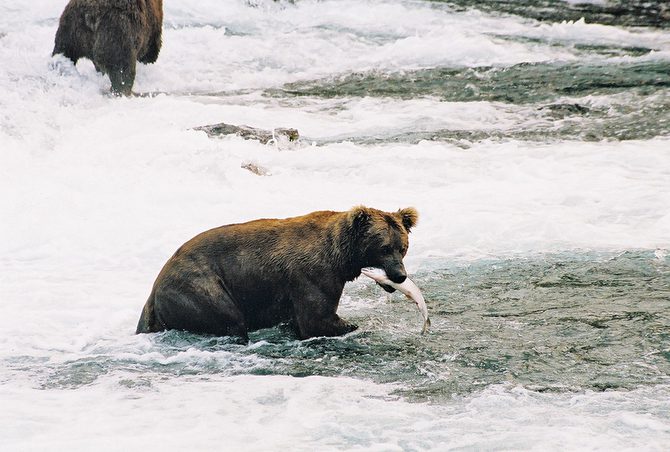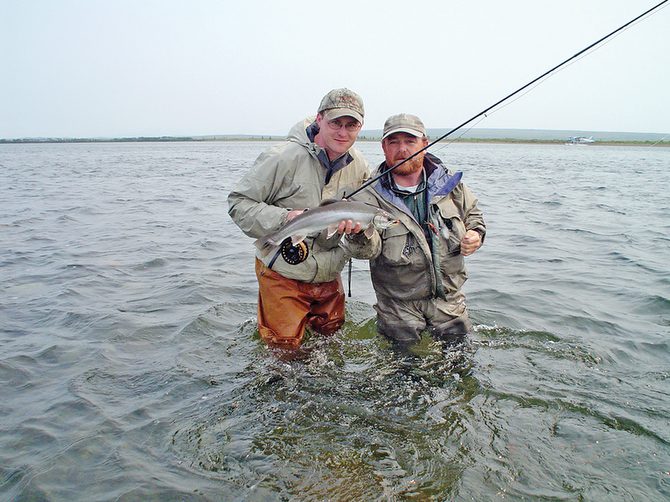By Nick Carter
Arguably the best salmonid fishing in the world exists in the system of waterways that feeds the Bering Sea on Alaska’s southwest coast. The region is a vast, sparsely populated web of streams and rivers, lakes and wetlands that weave through open tundra to Bristol Bay.
The wildlife is astounding. To be there is like stepping into a documentary film, with bears, moose and bald eagles going about their business unconcerned by human visitors. On a July afternoon, I watched in terror as a brown bear crashed from the brush, bluff charged my wife and stole the sockeye salmon from the end of her line. It’s that kind of place. From fancy lodges or tiny riverside fishing villages, human anglers are nothing special. They are just one of many species taking advantage of the great salmon migrations that drive the ecosystem.
All five species of Pacific salmon spawn in the Bristol Bay watershed. Coho, chum and pink salmon all make runs up the rivers that feed the bay. But king and sockeye salmon are the reason anglers should book passage to the area.
The Nushagak River boasts what might be Alaska’s best king, or Chinook, salmon run. Back bouncing egg sacks on heavy casting tackle, anglers regularly do battle with big kings in the 20- to 40-pound range.
Just a short puddle-jump down the coast, the Kvichak River hosts the largest sockeye salmon run on the planet. Sockeye pile into the river by the millions and push up into the headwaters to spawn and then die. For thousands of years, this transmission of nutrients from the sea inland has fueled the region’s wildlife, tundra and forests of alder and spruce. An angler with a fly rod can stand on the bank and cast streamers to huge pods of sockeye as they run past. Hooking one is no problem; it’s like collecting meat. The fight, however, is that of a creature determined to achieve its sole remaining purpose on earth.
These massive salmon runs feed all of the wildlife in the Bristol Bay region, and that includes rainbow trout, Dolly Varden, arctic grayling and others. Some area rivers are places where mouse patterns streaking across the surface draw aggressive strikes from rainbows 30-inches and longer. I can’t count the number of 25-plus-inch rainbows and Dollys we caught in a single day swinging big streamers. During and after the salmon runs, fish key in on salmon eggs and chunks of dead salmon adrift in the rivers. This is when egg patterns and flesh flies lead to unbelievable numbers of big fish.
It’s the kind of fishing that only occurs where humans have yet to make a pronounced impact on systems designed by nature. And that’s where the Bristol Bay fairytale is in danger of ending.
In 2005, gold, molybdenum and copper deposits were discovered underground near the headwaters of the Nushagak and Kvichak rivers, just a few miles from the banks of Alaska’s largest lake, Lake Iliamna. Ever since, conservation groups, sporting groups and locals have been waging a legal battle against greed to save this pristine landscape and fishery.
As proposed, the Pebble Mine would be an enormous scar on the landscape. According to The Wild Salmon Center, it would destroy an estimated 10,000 acres of wetlands and more than 330 miles of streams at the head of the most productive salmon fishery in the world. Annually, an estimated 10.6 billion gallons of mine-polluted wastewater would be sent downstream toward Bristol Bay.
For anyone who has ever fished or hopes to fish in a place as unspoiled as the Bristol Bay drainage, it’s unconscionable that such a project is even being considered.
For more information, visit savebristolbay.org.





